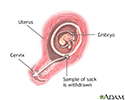Chorionic villus sampling
CVS; Pregnancy - CVS; Genetic counseling - CVS
Chorionic villus sampling (CVS) is a test some pregnant women have to screen their baby for genetic problems.
How the Test is Performed
CVS can be done through the cervix (transcervical) or through the belly (transabdominal). Miscarriage rates are slightly higher when the test is done through the cervix.
The transcervical procedure is performed by inserting a thin plastic tube through the vagina and cervix to reach the placenta. Your health care provider uses ultrasound images to help guide the tube into the best area for sampling. A small sample of chorionic villus (placental) tissue is then removed.
The transabdominal procedure is performed by inserting a needle through the abdomen and uterus and into the placenta. Ultrasound is used to help guide the needle, and a small amount of tissue is drawn into the syringe.
The sample is placed in a dish and evaluated in a lab. Test results take about 2 weeks.
How to Prepare for the Test
Your provider will explain the procedure, its risks, and alternative procedures such as amniocentesis.
You will be asked to sign a consent form before this procedure. You may be asked to wear a hospital gown.
The morning of the procedure, you may be asked to drink fluids and refrain from urinating. Doing so fills your bladder, which helps your provider see where to best guide the needle.
Tell your provider if you are allergic to iodine or shellfish, or if you have any other allergies.
How the Test will Feel
The ultrasound does not hurt. A clear, water-based gel is applied to your skin to help with the transmission of the sound waves. A hand-held probe called a transducer is then moved over your belly area. In addition, your provider may apply pressure on your abdomen to find the position of your uterus.
The gel will feel cold at first and may irritate your skin if not washed off after the procedure.
Some women say the vaginal approach feels like a Pap test with some discomfort and a feeling of pressure. There may be a small amount of vaginal bleeding following the procedure.
An obstetrician can perform this procedure in about 5 minutes, after preparation.
Why the Test is Performed
The test is used to identify any genetic disease in your unborn baby. It is very accurate, and it can be done very early in a pregnancy.
Genetic problems can occur in any pregnancy. However, the following factors increase the risk:
- An older mother
- Past pregnancies with genetic problems
- Family history of genetic disorders
Genetic counseling is recommended before the procedure. This will allow you to make an unhurried, informed decision about options for prenatal diagnosis.
CVS can be done sooner in pregnancy than amniocentesis, most often at about 10 to 12 weeks.
CVS does not detect:
- Neural tube defects (these involve the spinal column or brain)
- Rh incompatibility (this occurs when a pregnant woman has Rh-negative blood and her unborn baby has Rh-positive blood)
- Birth defects not due to a genetic cause
- Issues related to brain function, such as autism and intellectual disability
Normal Results
A normal result means there are no signs of genetic defects in the developing baby. Even though the test results are very accurate, no test is 100% accurate at testing for genetic problems in a pregnancy.
What Abnormal Results Mean
This test can help detect hundreds of genetic disorders. Abnormal results may be due to many different genetic conditions, including:
Talk to your provider about the meaning of your specific test results. Ask your provider:
- How the condition or defect may be treated either during or after the pregnancy
- What special needs your child may have after birth
- What other options you have about maintaining or ending your pregnancy
Risks
The risks of CVS are only slightly higher than those of amniocentesis.
Possible complications include:
- Bleeding
- Infection
- Miscarriage (in up to 1 in 100 women)
- Rh incompatibility in the mother
- Rupture of membranes which may lead to miscarriage
Considerations
If your blood is Rh negative, you may receive a medicine called Rho(D) immune globulin (RhoGAM and other brands) to prevent Rh incompatibility.
You will receive a follow-up ultrasound 2 to 4 days after the procedure to make sure your pregnancy is proceeding normally.
References
Cheng EY. Prenatal diagnosis. In: Gleason CA, Juul SE, eds. Avery's Diseases of the Newborn. 10th ed. Philadelphia, PA: Elsevier; 2018:chap 18.
Driscoll DA, Simpson JL. Genetic screening and diagnosis. In: Landon MB, Galan HL, Jauniaux ERM, et al, eds. Gabbe's Obstetrics: Normal and Problem Pregnancies. 8th ed. Philadelphia, PA: Elsevier; 2021:chap 10.
Dugoff L, Wapner RJ. Prenatal diagnosis of congenital disorders. In: Lockwood CJ, Copel JA, Dugoff L, et al, eds. Creasy and Resnik's Maternal-Fetal Medicine: Principles and Practice. 9th ed. Philadelphia, PA: Elsevier; 2023:chap 30.
Graham GM, Park JS, Norwitz ER. Antepartum fetal assessment and therapy. In: Chestnut DH, Wong CA, Tsen LC, et al, eds. Chestnut's Obstetric Anesthesia: Principles and Practice. 6th ed. Philadelphia, PA: Elsevier; 2020:chap 6.
Review Date: 11/10/2022
Reviewed By: John D. Jacobson, MD, Department of Obstetrics and Gynecology, Loma Linda University School of Medicine, Loma Linda, CA. Also reviewed by David C. Dugdale, MD, Medical Director, Brenda Conaway, Editorial Director, and the A.D.A.M. Editorial team.













